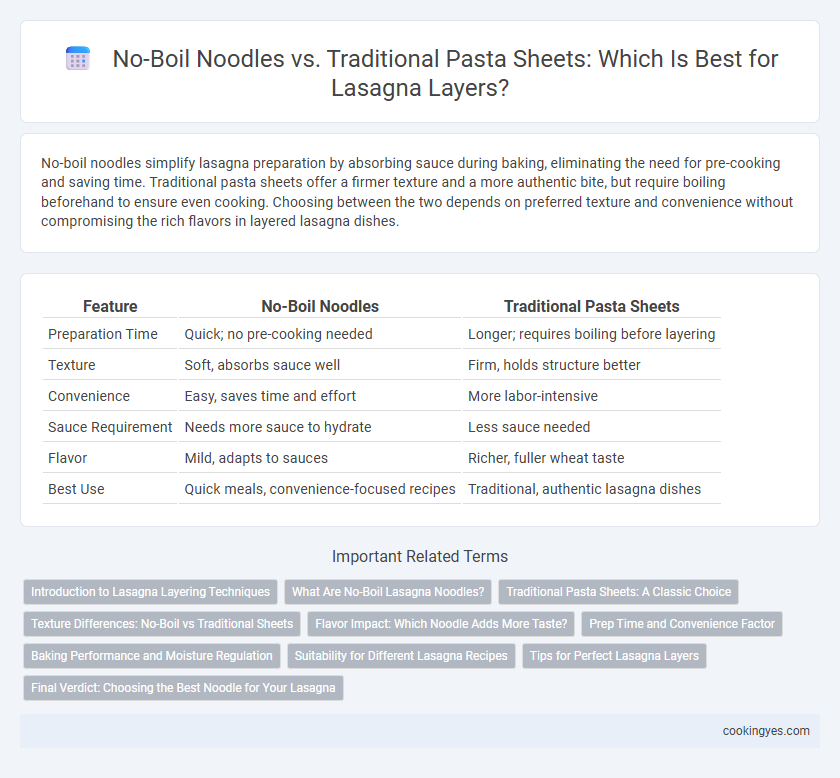No-boil noodles simplify lasagna preparation by absorbing sauce during baking, eliminating the need for pre-cooking and saving time. Traditional pasta sheets offer a firmer texture and a more authentic bite, but require boiling beforehand to ensure even cooking. Choosing between the two depends on preferred texture and convenience without compromising the rich flavors in layered lasagna dishes.
Table of Comparison
| Feature | No-Boil Noodles | Traditional Pasta Sheets |
|---|---|---|
| Preparation Time | Quick; no pre-cooking needed | Longer; requires boiling before layering |
| Texture | Soft, absorbs sauce well | Firm, holds structure better |
| Convenience | Easy, saves time and effort | More labor-intensive |
| Sauce Requirement | Needs more sauce to hydrate | Less sauce needed |
| Flavor | Mild, adapts to sauces | Richer, fuller wheat taste |
| Best Use | Quick meals, convenience-focused recipes | Traditional, authentic lasagna dishes |
Introduction to Lasagna Layering Techniques
No-boil noodles simplify the lasagna layering process by softening directly in the sauce, reducing prep time without compromising texture. Traditional pasta sheets require pre-cooking or soaking to achieve the ideal tenderness, offering a slightly firmer bite and classic layered structure. Choosing between no-boil and traditional sheets impacts the dish's moisture balance and overall mouthfeel, crucial for achieving perfectly distinct layers in lasagna.
What Are No-Boil Lasagna Noodles?
No-boil lasagna noodles are precooked pasta sheets designed to soften during the baking process without prior boiling, saving preparation time and simplifying assembly. These noodles absorb sauce and moisture from the lasagna layers, resulting in tender and evenly cooked pasta throughout the dish. Unlike traditional pasta sheets that require boiling beforehand, no-boil noodles offer convenience while maintaining the classic texture and structure essential for authentic lasagna.
Traditional Pasta Sheets: A Classic Choice
Traditional pasta sheets offer a classic choice for lasagna layers, known for their firm texture and ability to absorb rich sauces during baking. Made from durum wheat semolina and eggs, these sheets provide a more authentic flavor profile compared to no-boil noodles. Their slightly chewy consistency enhances the overall dining experience, making them a preferred option for traditional lasagna recipes.
Texture Differences: No-Boil vs Traditional Sheets
No-boil noodles produce a softer, more uniform texture in lasagna layers due to their pre-cooked composition, which allows them to absorb sauce directly during baking. Traditional pasta sheets offer a firmer, chewier bite and maintain distinct layer separation when boiled to al dente before assembly. The choice between no-boil and traditional sheets significantly affects the lasagna's mouthfeel, with no-boil sheets creating a creamier consistency and traditional pasta preserving a more structured, textured experience.
Flavor Impact: Which Noodle Adds More Taste?
No-boil noodles absorb sauce and spices directly during baking, enhancing the overall flavor profile of lasagna layers by blending seamlessly with ricotta, marinara, and mozzarella. Traditional pasta sheets offer a firmer texture with a subtle wheat taste, allowing the tomato sauce and cheese to remain the dominant flavors. Chefs seeking a richer, integrated taste often prefer no-boil noodles for their ability to infuse every bite with concentrated seasoning and moisture.
Prep Time and Convenience Factor
No-boil noodles significantly reduce prep time by eliminating the need to pre-cook pasta sheets, allowing for quicker assembly of lasagna layers. Traditional pasta sheets require boiling, which adds extra steps and time but can offer a firmer texture. Convenience favors no-boil noodles, especially for busy cooks seeking a streamlined process without compromising flavor absorption.
Baking Performance and Moisture Regulation
No-boil noodles simplify lasagna preparation by absorbing sauce during baking, resulting in evenly cooked layers with consistent moisture retention. Traditional pasta sheets require pre-cooking to avoid dryness but deliver a firmer texture and distinct bite due to controlled moisture absorption. Baking performance favors no-boil noodles for ease and moisture balance, while traditional sheets offer customizable texture through precise pre-boiling techniques.
Suitability for Different Lasagna Recipes
No-boil noodles offer convenience and absorb sauces faster, making them ideal for quick or lighter lasagna recipes like vegetable or white sauce lasagnas. Traditional pasta sheets provide a firmer texture and better structural integrity, preferred in meat-heavy or classic Bolognese lasagnas where longer baking times develop richer flavors. Choosing between no-boil and traditional pasta sheets depends on the lasagna's sauce consistency and cooking duration to achieve the desired texture and taste balance.
Tips for Perfect Lasagna Layers
No-boil noodles offer convenience and absorb sauce during baking, ensuring tender, well-cooked layers without pre-cooking, while traditional pasta sheets provide a firmer texture when boiled properly. To achieve perfect lasagna layers, evenly spread sauce on each noodle, avoid overlapping sheets, and allow sufficient resting time after baking for layers to set. Using high-quality pasta or no-boil noodles with consistent thickness enhances texture and structural integrity in every bite.
Final Verdict: Choosing the Best Noodle for Your Lasagna
No-boil noodles offer convenience by absorbing sauce during baking, resulting in a tender, evenly cooked layer without pre-cooking, making them ideal for quick preparation. Traditional pasta sheets provide a firmer texture and allow greater control over doneness, preferred by those seeking a classic, chewy bite and the ability to customize each layer. The best choice depends on time constraints and texture preference, with no-boil noodles favored for speed and ease, while traditional sheets excel in flavor depth and structural integrity.
No-boil Noodles vs Traditional Pasta Sheets for Lasagna Layers Infographic

 cookingyes.com
cookingyes.com